Why I bought Honda's plug-in hybrid mystery car
At Christmastime, in the noble tradition of proud parents everywhere, I unloaded — I mean, generously donated — my 2009 Honda Fit to my college-student son.
That gesture wasn’t pure, heart-warming nobility; I wanted a new car. Specifically, an electric car.
I don’t know if you’re aware of how juicy the deals are on these things. Obviously, the main reason you’d get one is because they’re much better for the environment. (Yes, they run on electricity, which still requires burning some fossil fuels to generate — but the impact of electric cars is drastically lower than gas cars.)
But even if you don’t care about being green, an EV (electric vehicle) still get you all of this:
A tax credit from the Federal government. That’s not a tax deduction, which lowers your income before you calculate the tax. It’s a tax credit, which is money in your pocket after taxes. Depending on the car’s electric range, it’s up to $7,500.
Money back from the state. Forty-five states currently offer juicy EV incentives, usually cash. I live in Connecticut, where it’s $2,000. Nothing to do with taxes — it’s just a check they send you.
You save tons of gas money. Electric-car owners never, ever pay for gas. Your electric bill goes up, of course, but you still come out ahead: You pay about $3.50 per 100 miles (electric) instead of $8 per 100 miles (gas), based on national averages.
Special parking places. My Connecticut town is more progressive than most, but it’s got dedicated electric-car parking spaces at the grocery, library, train stations, town hall, and so on. They’re right next to the handicap spaces, and each one has a charging station. (There are 36,000 of these free public charging stations in the U.S.) Free electricity while you’re shopping!
Drive alone in the carpool lane. Many states welcome EVs to the carpool (HOV) lane.
The brakes last, like, forever. When you brake, magnets capture your momentum and use it to recharge the battery, saving the brake pads.
They ZOOM! An electric car has incredible torque (translation: instant acceleration). They are fun!
They’re silent. There’s no engine noise, obviously. You hear only a faint hum/whine when you put the pedal down. Your music sounds that much better.
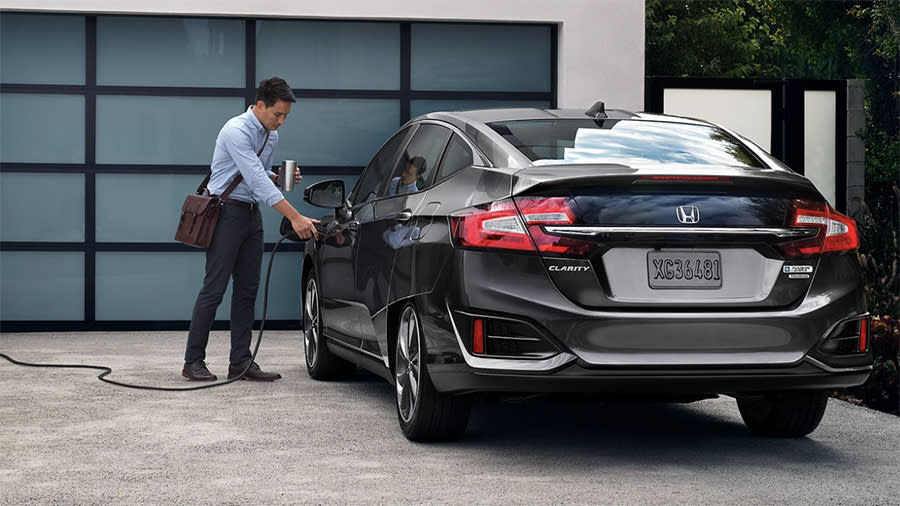
Of course, we all know why more people aren’t buying electric cars: range anxiety. Unless you’ve got something like a Tesla or a Chevy Bolt (over 200 miles on a charge), you’re limited in the drives you can take. And it’s not like you can pull into a station and refuel in five minutes. You have to plan your life around charging stops: lunch, overnight stays. It’s a hassle.
But here’s the point of this article: There is a way to get all the advantages of electric without the range anxiety: plug-in hybrids. (Geeks call them PHEVs, for plug-in hybrid electric vehicles. Man, they really need a catchier name.)
A plug-in hybrid is electric with a gas-engine backup. Once the big battery’s dead, the car becomes a regular hybrid, like a Prius or whatever. Amazingly, the gods of legislation have determined that these cars are entitled to all the same goodies that pure electrics are.
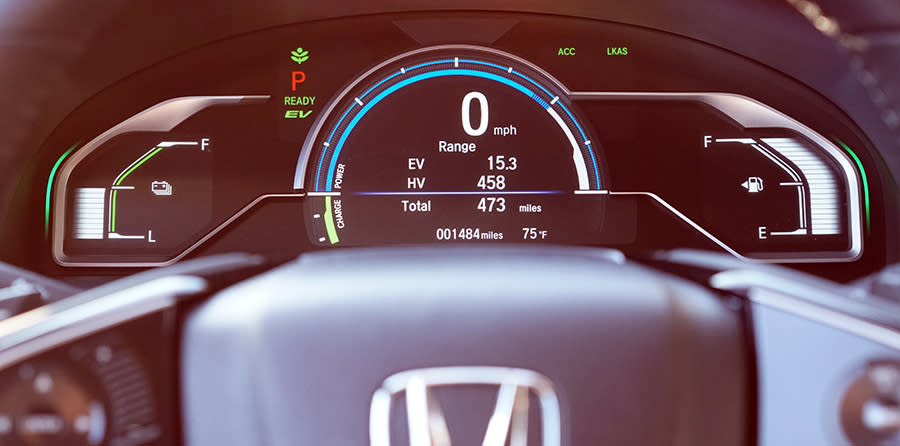
You can plug in one of these cars into a standard power outlet in your garage, as you would a lamp or something; it charges overnight. Or you can install a 240-volt outlet, like the one for a washer or dryer; the car charges in a couple of hours. (Handily enough, public charging stations are 240V, too.)
There are lots of plug-in hybrid models. As a handy benefit, most of them are loaded with the latest autonomous safety features:
Lane keeping. If you start to drift out of the lane without your blinker on, the car warns you and guides you back into the lane.
Collision avoidance. If you’re coming too fast toward a slowing car ahead, the car warns you and actually brakes for you to avoid a collision.
Adaptive cruise control. You set a speed you want to maintain — let’s say 65 mph. At that point, the car speeds up and slows down (even stopping, if necessary) as necessary to avoid hitting the car in front of you. A button on the wheel controls how many car lengths you want your car to hang back.
Self-parking. Well, sort of: The car turns the wheel for you, but you still have to manage the shift lever and gas/brake pedals.
Here’s the journal of my quest to buy the perfect plug-in hybrid family car — and why we wound up buying an obscure, no-name Honda in the end.
Prius Prime
My wife and I started with a test drive at the local Toyota dealership. Our other car is a Prius, which we’ve always loved. (If the Tesla 3 I ordered two years ago ever shows up, we’ll sell the Prius.)
Anyway, we liked the looks of the Prius Prime, a plug-in hybrid. OK, we didn’t actually like the looks, but — you know.

Here’s what we loved about this car:
The price. The base model is $27,100. The Federal tax credit is $4,500 for this model. With the Connecticut kick-in, my final price would be $20,600.
The hybrid MPG. You go 25 miles on pure electric; after that, the hybrid (gas-and-electric) mode gets an amazing 55 miles a gallon. Total range is 640 miles on one gas tank, which is extraordinary.
The wireless phone charger. If you have a recent iPhone or Samsung Galaxy, for example, you can just set it down in the center console — it instantly starts to charge, magnetically.

Cool smart stuff. Lane-departure warning, front-collision braking, and automatic high beams are all included in the base model.
The heads-up display. Just as on a fighter jet, the Prime can project important stats in space in front of the driver — your charge status, speed, current speed limit. It seems to hover a few feet in front of the windshield.
Here’s what we didn’t love:
It’s a four-seater. My wife and I have a blended family with, on and off, five kids. We’d really miss a fifth seat.
The trunk is the size of a subatomic particle. The batteries in this baby take up most of what would have been the trunk. We sometimes have to drive to our kids’ colleges in Massachusetts and Vermont, loaded up with stuff. That wasn’t gonna work.
25-mile electric range. That’s really not a lot. Would 25 miles cover your commute both ways? Remember that cold weather can cut your battery capacity in half.
All touchscreen. No volume knob at all. Auuugh! And no Apple CarPlay or Android Auto.

The ride. Man, this car hates rough pavement. It’s a bumpy ride. Also, as Car & Driver puts it, this is no sports car. “You buy this car to pass gas stations, not other vehicles.”
The good stuff costs. The heads-up display, phone charger, self-parking, and blind-spot monitor stuff are available only on the higher-end models, which erase a lot of the price advantage.
Chevy Volt
Man, if you want electric range (and you do), it’s hard to beat the Chevy Volt. This baby goes 53 miles on pure electric, more than any other PHEV. For a lot of people, especially commuters, that should cover it most of the time. (It’s easy to confuse this car with the Chevy Bolt, which is all electric — 238 miles of range, no gas hybrid mode.)
We took a test drive, and concluded that we loved these things about the 2018 Volt:
53-mile pure electric range. Of course, that also means it takes longer to charge fully: 13 hours on 120V, and 4.5 on 240V.
Super fun to drive. It’s a great ride.
It looks amazing. It’s a great-looking car.
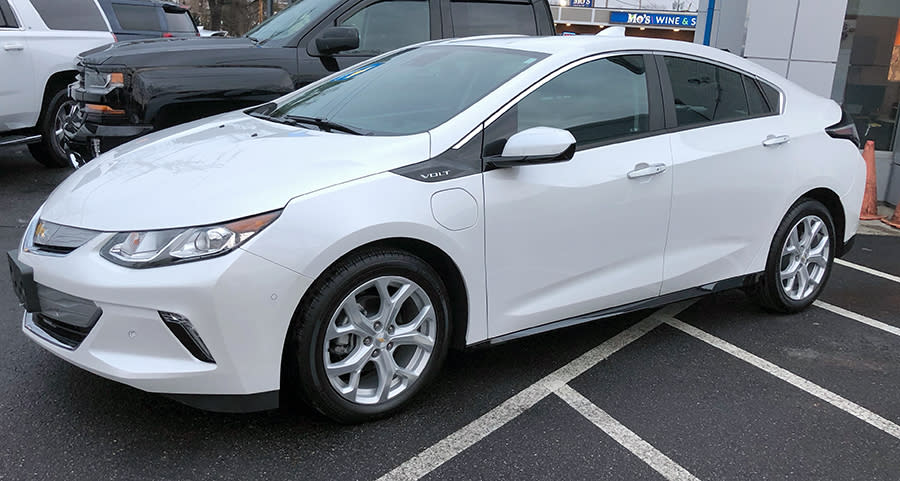
There’s also, unfortunately, quite a bit not to like:
It’s another four-seater. Chevy says it seats five, but that’s hilarious. You’d fit in the back middle seat only if you were a Barbie doll. Even the two actual rear seats are super-cramped; at 6 feet 2 inches, my head was mashed firmly against the roof.

It’s claustrophobic. Visibility is not good from the driver’s position.
It’s pricey. The base price is $34,100 — that’s $7,000 more than the Prius Prime. If you want the self-driving stuff (lane keeping, forward collision avoidance, self parking), the grand total is $40,000! Yeah, the tax credits and refunds will help, but… wow. This is a subcompact car.
The marketplace
We sat down that night to look at our other options. There’s a huge range of plug-in hybrids available; here’s a sample, showing base price and electric range. Notice anything in common with their all-electric ranges?
Audi A3 eTron: $37,900, 16 miles
BMW 330e: $44,100, 14 miles
Chrysler Pacifica (minivan!!): $42,000, 33 miles
Ford C-Max Energi SE: $27,120, 20 miles
Ford Fusion Energi: $31,100, 22 miles
Hyundai Sonata PHEV: $34,600, 27 miles
Hyundai Ioniq PHEV: $25,000, 29 miles
Kia Niro PHEV: $27,900, 26 miles
Kia Optima PHEV: $35,210, 29 miles
MiniCooper S E Countryman: $36,800, 18 miles
Volvo XC90 (SUV): $67,800, 14 miles
Those are puny ranges! What’s the point of a plug-in when you can drive only 9 miles in cold weather?
The Honda Clarity
In late December, we were just about to pull the trigger on the Chevy Volt when my wife suggested one final Google search. And incredibly, something popped up that I hadn’t seen before: Something called the Honda Clarity.

It seemed to have everything we wanted: Room for five adults, full-sized trunk, all the cool autonomous features included in the base model, and 47 miles of electric range! That would make it the No. 2 longest-range plug-in hybrid on the market — and the only midsize, five-adult car with that kind of range.
I found that bizarre, and I still do. Why does the industry think nobody wants a family car with great electric range?
The weird thing is that this car was a total mystery. There was nothing about it online. No reviews —only a few blogger descriptions of a test-driving event Honda staged last fall. The local dealers didn’t know anything about it. There were no ads or marketing of any kind.
(Part of the confusion, no doubt, is that there are two other Honda Clarities: One’s pure electric, and one runs on hydrogen!)
We found a dealer an hour away with one Clarity in stock, and took it for a test drive. The car was an utter mystery to our salesman. He told us, for example, that the car is three feet longer than the Chevy Volt (it’s actually one foot longer), and that it takes 19 hours to charge (it actually takes 12, or 2.5 hours with a 240V outlet). He had no idea how to turn on the autonomous features. And the car hadn’t been charged, so we had to take our test drive on gas (42 mpg).
Here’s what we loved:
The ride. Maybe it’s because this is a midsize, and most of the others are compacts — but man, what a glorious ride. It floats like a magic carpet, except that you still have a great feeling of the road. And it’s so quiet on electric! Combine that with the zoomy acceleration from a stop (232 foot-pounds of torque, if you’re scoring at home), and you’ve got a really fun car to drive.
The space. Our kids have never known anything but compact cars. They could not believe the headroom and legroom when they climbed in.
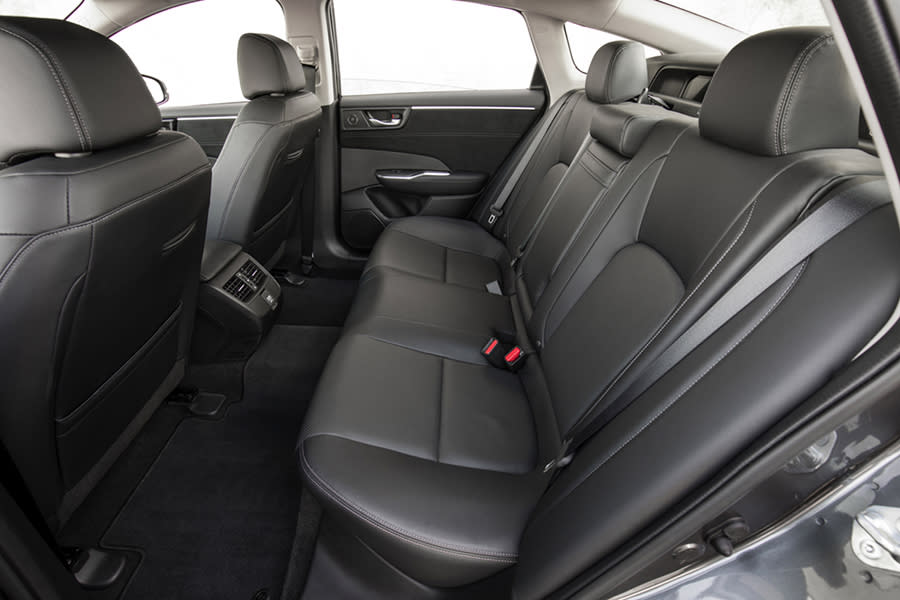
The trunk. It’s really big. But it’s weirdly shaped. It has a secondary sub-trunk, accessed with a trapdoor, and when the seats are folded down, the pass-through hole to the front is bizarrely shaped. But yeah — plenty of suitcases.

Adaptive cruise control. Unlike most cars with this feature, the Clarity’s adaptive cruise works even at low speeds, like in stop-and-go suburban traffic. It works really well. I use it a lot.
Blind-spot screen. When you turn on the right turn signal, the dashboard screen becomes a closed-circuit TV, showing you your right-side rear view. No more blind spot! (There’s nothing equivalent when you turn left, alas.)
Cup-holder cup holders. Each cup holder has two flip-out tabs to accommodate taller or narrower cups and bottles. A clever touch.

Auto-lock and unlock. The car unlocks itself as you approach (with the key fob on you), and can also auto-lock once you’re 15 feet away.
Phone pockets in the back. Such a little thing, but so great: A place to hold the back-seaters’ phones to get them out of the way.

A warning chord. OK, so you’ve got a totally silent car. How does it warn pedestrians that it’s in motion? Most electric cars play some kind of beep or white noise at low speeds; the Clarity plays a chord—a singing, sustained, musical orchestra chord—very softly, until you hit 12 mph. (You can turn it off.)
Smart fob. You get two key fobs with the car, labeled Driver 1 and Driver 2. As you approach the car, it unlocks automatically, of course — but it also moves the driver’s seat into your preferred position and angle automatically, as memorized by your fob. (The fob should also adjust the rear-view and side mirrors, temperature, and radio stations for each driver, too. Well, someday.)
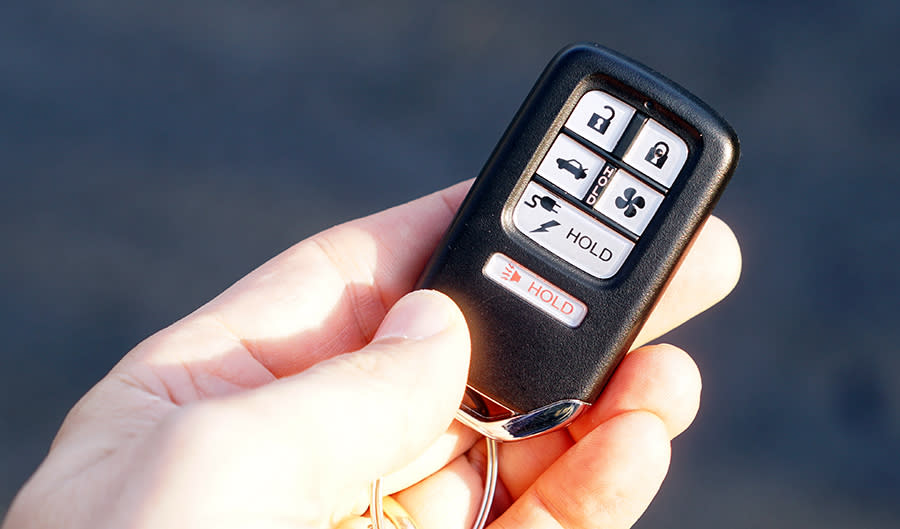
Bio–plastics. The fabric surfaces inside are made of plants, not petroleum; on the high-end model, the dash is covered by suede, which looks and feels cool and is made of recycled material.
LED lights. All the lights — front, rear, turn signals — are LEDs, and they look awesome.
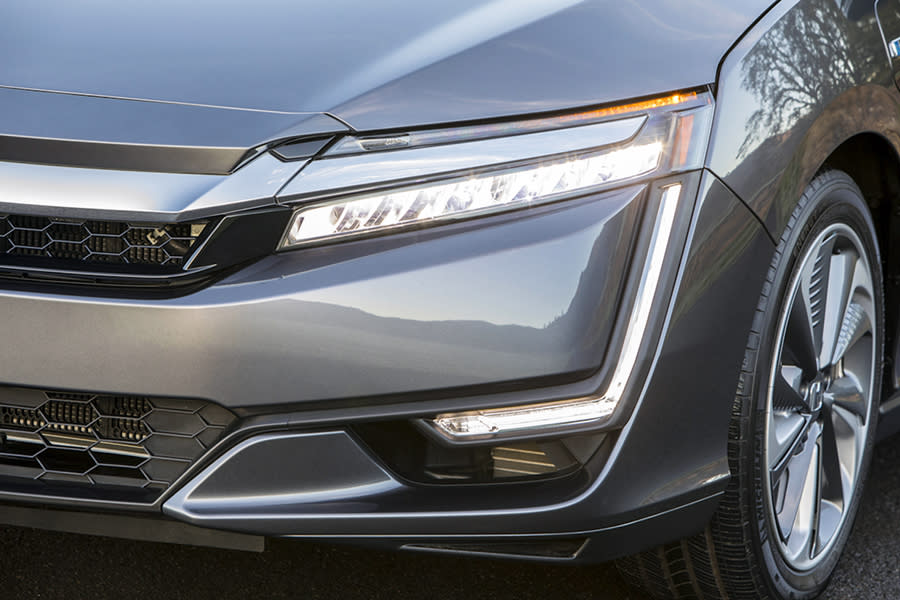
All the goodies. So much stuff is included in the base model ($33,400)! Lane-keeping, front-collision auto-braking, adaptive cruise control. Apple CarPlay and Android Auto. An 8-inch touchscreen that’s not horrible. (There’s no volume knob, but a physical volume control is on the steering wheel.) Automatic high-beam dimming. Automatic rear-view-mirror dimming at night. Side-mirror heating, front-seat heating.
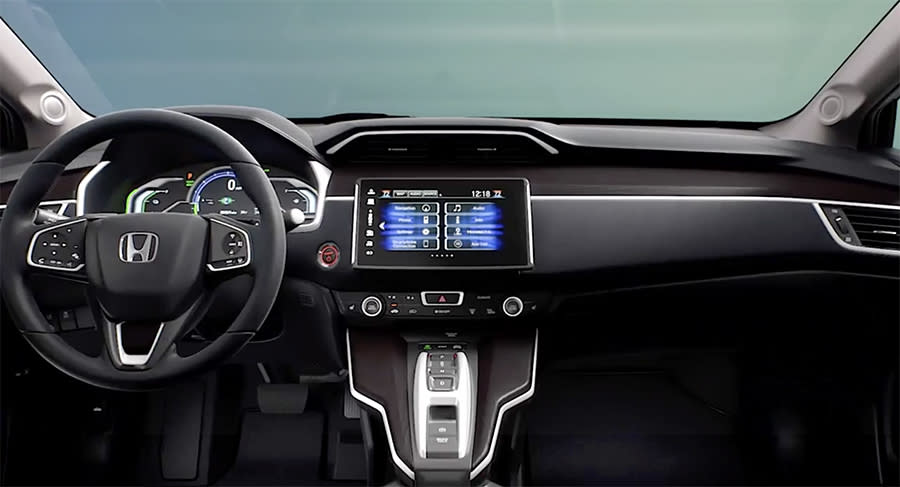
The price. At $33,400, the Clarity is pricier than the Prius Prime ($27,100), but it definitely beats the much smaller Chevy Volt, comparably equipped ($40,000). The Clarity also earns the full $7,500 back from the government, plus, in my case, $2,000 back from the state of Connecticut. My final price would be $23,900.
The Touring model ($36,600) adds eight-way power-adjustable driver’s seat, leather seats, a built-in navigation system, and remote-control heating/cooling (you hit a button on the fob while you’re finishing breakfast).
We quickly found a few things we didn’t like, too:
It’s kind of ugly in back. The car looks great from the front, but the back end strikes us as weird/ugly. Some of that comes from aerodynamics: The back wheels are partly covered, for example; the bottom of the car is completely enclosed and flat; and funny little wind intake holes are tucked in the grille and in front of the rear wheel.
Lane assistance barely works. When the Clarity starts to creep out of the lane, it’s supposed to alert you (by vibrating the wheel and flashing a warning) and auto-steer gently back into the lane. It works amazingly well — when it works. But it doesn’t kick in until you’re going over 45 mph, and even then, it doesn’t seem to notice when it’s creeping over a yellow center line.
Occasional engine noise. When the gas has to kick in, it can be loud, and out of proportion to the accelerator position.
The paddles. Behind either side of the steering wheel, your fingers easily reach two paddles. They govern regenerative coasting, in four levels. That is, tug the left paddle four times, and your car really slows down during coasting (to recharge the battery more); tug the right one to lighten up. That setting resets to 0 when you next use the accelerator, though. Honda told me that “this feature can be especially useful as you drive downhill,” but using the brake also recharges the battery, so… why?
No self parking. Oh well.
No USB in back. There’s a cigarette-lighter charger in the back for the kids’ phones — but why on earth no USB jacks?
The name Clarity. My wife thinks it sounds like an antihistamine.
The biggest adjustment we had to make was accepting that the Clarity is a midsize car. Obviously, that’s why we get such great interior space, but it also means a wider turning radius and tighter parking. Mainly, my wife and I both grew up thinking that bigger cars equals worse fuel economy. It’s a mind-fuddler to realize that this is our green car!
So guess what? We bought it.

Two months in
All of that happened the first week of January. I’m happy to report that some reviews for the Clarity are finally starting to appear online (spoiler: they like it too), and Honda Inc. is starting to do some marketing and dealer training, too. I guess we were just geniuses, buying this car before the world knew it was great.
The good news is that owning a plug-in hybrid is exactly what it’s cracked up to be: Super fun to drive, instant acceleration, and NO GAS STATIONS. We come home, we plug in the cable, we never use gas. We drive it every day, and we’ve refilled the gas tank once in two months (I had to drive to JFK airport in freezing weather).
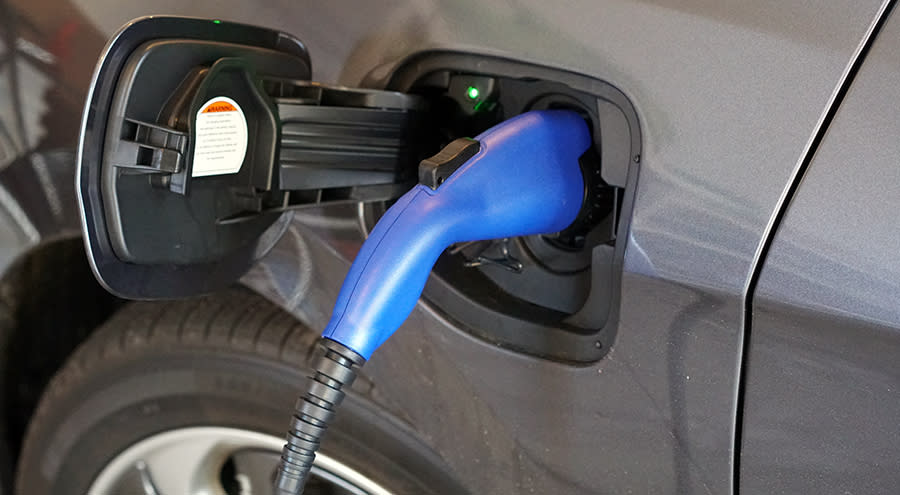
The dealers I interviewed for the video above all say that consumers aren’t jumping on PHEVs the way you’d expect. It’s because people don’t know about plug-in hybrids, or don’t understand them, or don’t like change.
Well, if that’s you, change your mind; you’re crazy not to look into this category. Who doesn’t like saving money and getting a zippier car?
All three dealers also said I should have leased the car instead of buying it, because technology is moving along so quickly, this car will seem out of date in a few years. Of course, that’s what a dealer would say, right? But it’s something to consider.
Then again, if it gets to the point where I can’t stand having an ancient 2018 car, I won’t be stuck with it. I’ve got three more kids who will one day head off to college.
David Pogue, tech columnist for Yahoo Finance, welcomes non-toxic comments in the Comments below. On the Web, he’s davidpogue.com. On Twitter, he’s @pogue. On email, he’s [email protected]. You can sign up to get his stuff by email, here.
